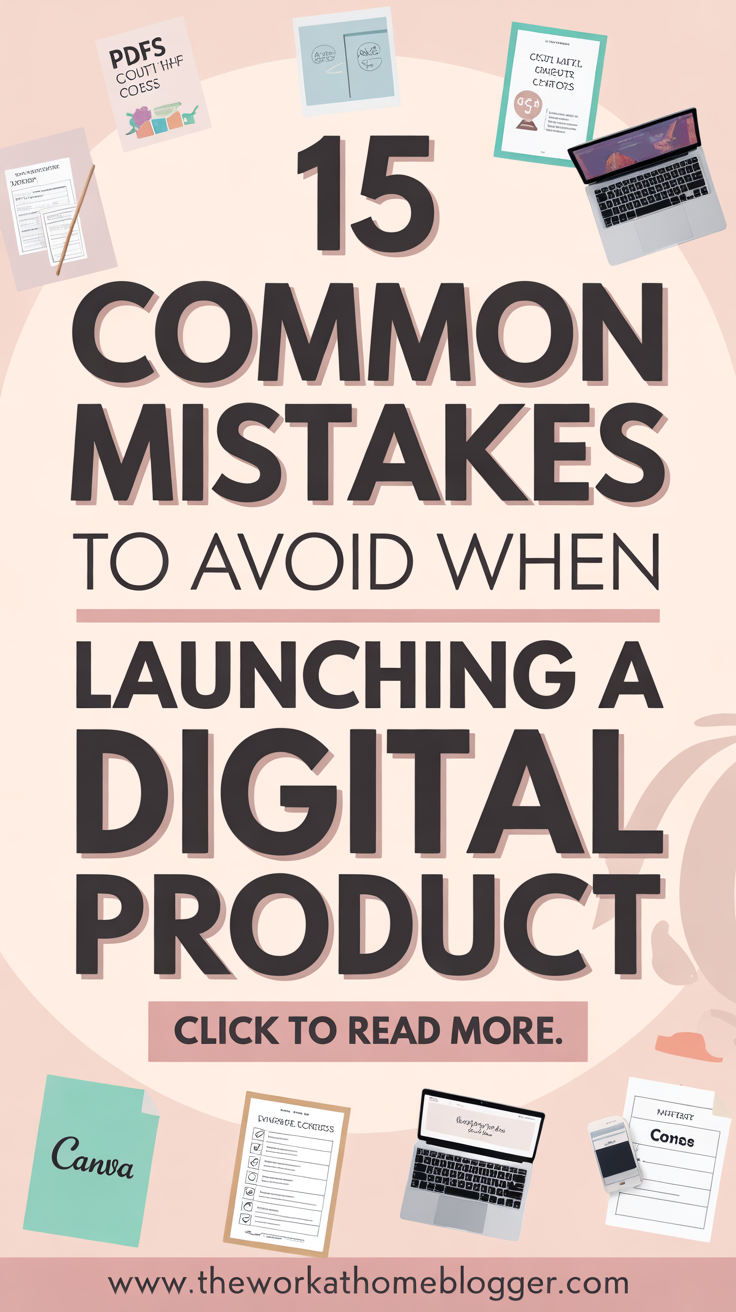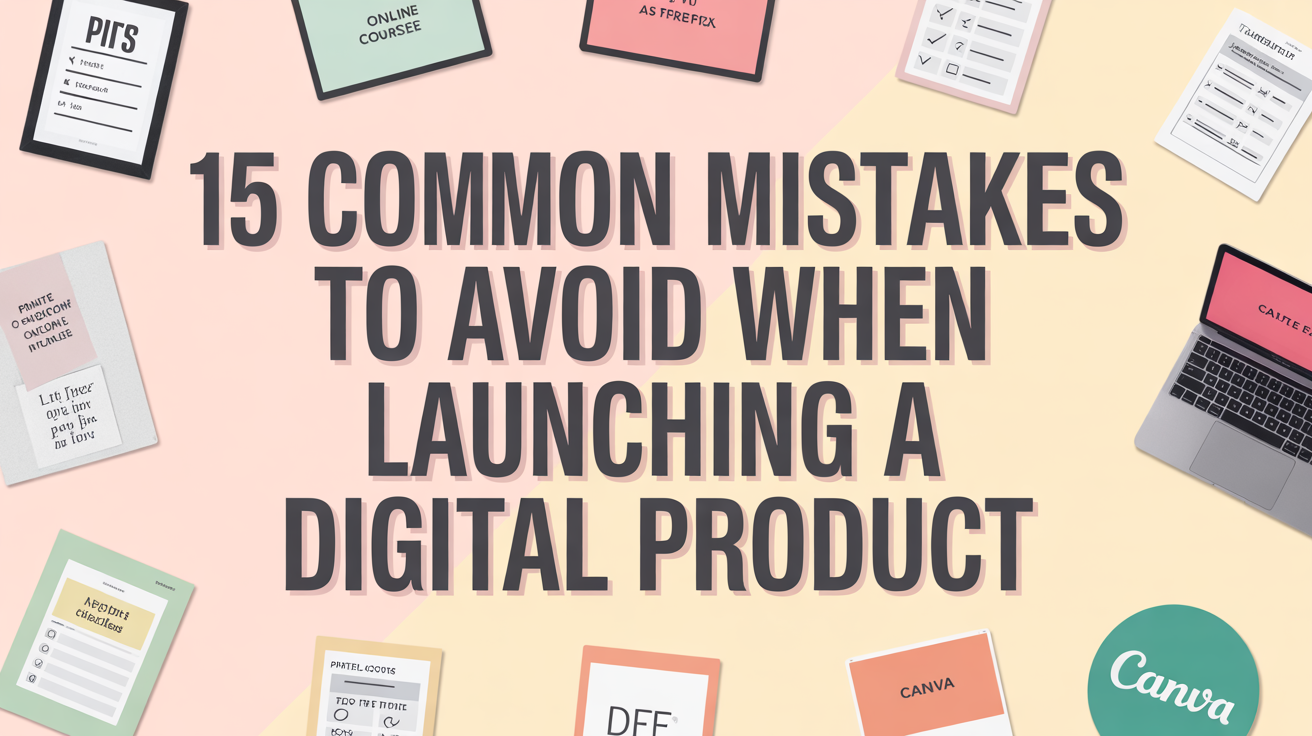This blog post will discuss the most common mistakes when launching a digital product. It’s crucial to recognize that launching a digital product comes with its own set of challenges. As I navigated this journey, I learned that avoiding common pitfalls can mean distinguishing between success and frustration.
One of the hardest lessons I’ve learned throughout my years of launching my digital product store is understanding my audience. Knowing what my audience is looking for when visiting my blog made me realize the importance of understanding the data.
So, my advice to you is to please understand your target audience and their needs; neglecting this can lead to wasted resources.
Additionally, testing your product thoroughly before launch is vital to avoid negative feedback. By removing these missteps, you can set your digital product up for a more successful launch.
Key Takeaways:
- Neglecting market research can lead to misaligned product features with customer needs, so it’s essential to understand your target audience before launch.
- Underestimating the importance of a marketing strategy may result in low visibility; developing a comprehensive plan can help ensure successful outreach and engagement.
- Overlooking user feedback after launch can hinder product improvement; actively soliciting and incorporating feedback can enhance user experience and satisfaction.
The Perils of Insufficient Market Research
Launching a digital product without thorough market research can lead to catastrophic missteps.
Skipping this vital step risks developing a product or service that the market doesn’t want or need. In an overly crowded digital space, mere intuition isn’t enough.
Gathering insights about potential customers, current trends, and industry needs sets the foundation for a successful launch.
For instance, an online course can be taken through a Zoom call with Google Docs. Using free tools to beta test your digital product is one of the best ways to plan how to execute your product launch.
Misjudging Target Audience Needs
Failing to accurately gauge your target audience’s needs can result in a product that doesn’t resonate.
Making assumptions based on your preferences or limited feedback is tempting, but relying solely on this can lead to wrong features or services without actual demand.
You can validate your audience’s real desires by employing methods such as surveys and focus groups, preventing costly miscalculations.
Ignoring Competitor Analysis
Understanding your competition provides crucial insights into what works and what doesn’t. Overlooking competitor analysis can lead to missed opportunities to innovate your offering or differentiate your solution.
You might find yourself putting unnecessary effort into an existing feature or not realizing the gaps competitors fail to address.
By taking a closer look at your competitors, I often observe patterns that can be instructive. Analyzing their pricing strategies, customer feedback, and marketing techniques helps identify weak spots in their offerings.
For instance, if a rival consistently gets negative reviews for a specific aspect, capitalizing on that pain point can give your product a unique edge.
Utilize tools like SWOT analysis to evaluate their strengths and weaknesses, allowing your product to compete and thrive in a challenging marketplace.

The Costly Error of Underestimating Pricing Strategy
Setting the right price for your digital product can make or break your launch. Too low, and you risk undervaluing not only your product but also your brand; too high, and you might deter potential customers. A well-thought-out pricing strategy involves examining industry standards, conducting market research, and understanding your target audience’s willingness to pay. I’ve seen firsthand how overlooking this often leads to missed revenue opportunities and a tarnished reputation.
Common Pitfalls in Setting Product Prices
One of the biggest traps is using a one-size-fits-all approach. Many emerging entrepreneurs make the mistake of simply copying competitor prices or reducing them in hopes of gaining traction. This often backfires, as failing to align the price with the unique value proposition can lead to confusion and, in the worst cases, loss of customer trust. Understanding the market dynamics and analyzing competitors and consumer behavior is critical to avoid these pitfalls.
Balancing Value and Consumer Perception
Conveying the correct value is an art. Pricing should reflect not only the tangible benefits of your product but also how it fits into your audience’s lives. For example, a $50 app that saves users $500 annually is perceived as a bargain. Conversely, a $10 product that offers minimal value might generate skepticism. Striking the right balance between perceived value and actual benefits drives purchasing decisions, so I prioritize gathering feedback to optimize this perception.
When I analyze consumer perception, I leverage tools such as surveys and A/B testing to gauge how potential customers respond to varied price points. By layering in testimonials and case studies, the perceived value increases as you clearly articulate the product’s benefits. Witnessing how even slight adjustments in pricing and positioning can yield substantial changes in consumer behavior reinforces the notion that a thoughtful approach to pricing can significantly impact your digital product launch’s success. Always remember that your price points should resonate with your audience while reflecting the quality and uniqueness of your offering.
The Trap of Overcomplication in Product Features
A common pitfall in the digital product launch process is the temptation to cram in too many features, believing that more complexity equals a more valuable product.
This often leads to confusion for users, overwhelming them with options instead of providing a straightforward, efficient experience.
Simplifying your product’s offering enhances user experience and clarifies your value proposition, making it easier for customers to understand and engage with your services.
For instance, [insert example of a product that succeeded by simplifying its features].
Minimizing User Experience for Complexity
Overly complex features can easily minimize user experience, creating barriers instead of facilitating engagement. When you layer in too many functionalities, users might be lost or frustrated, leading to high abandonment rates. Prioritizing a clean, intuitive design fosters an environment where people can effortlessly navigate your product, which is necessary for retaining customer interest and promoting positive reviews.
The Value of a Minimum Viable Product
Developing a minimum viable product (MVP) allows you to test your core idea without drowning in extraneous features. An MVP contains just enough functionality to satisfy early adopters and gather invaluable feedback. This approach minimizes risk by confirming product-market fit before investing resources into additional developments, ensuring you focus on what truly matters to your target audience.
By launching an MVP, I can validate my concept quickly and cost-effectively. For example, Dropbox initially introduced a simple video demonstration instead of a fully developed platform. This confirmed interest and gathered early insights into user behavior and preferences. This iterative approach empowers you to scale your product based on honest user feedback, allowing for informed decisions and ultimately leading to a product that resonates better with your audience.
Failure to Establish a Strong Marketing Plan
Launching a digital product without a solid marketing plan can lead to missed opportunities and lackluster sales. I’ve seen countless entrepreneurs underestimate the power of strategy, diving straight into promotion without considering their target audience, messaging, or channels. Without a structured approach, even the most innovative products struggle to gain traction, often resulting in wasted resources and diminished potential.
Overlooking Multi-Channel Promotion
Limiting your promotional efforts to a single platform is limiting your reach. A thriving digital product requires visibility across multiple channels, from social media and email marketing to partnerships and guest blogging. You can connect with various demographics by leveraging diverse platforms, maximizing your exposure and engagement. A balanced, multi-channel strategy ensures you don’t miss out on potential customers.
The Importance of Building Anticipation
Generating excitement before your product launch significantly improves initial sales. Anticipation can be cultivated through sneak peeks, countdowns, and behind-the-scenes content, creating a buzz that converts into eager customers once your product drops. A well-timed marketing campaign builds interest, engages your audience, and paves the way for a successful launch.
During my product launches, I’ve seen firsthand how a strong pre-launch strategy can spark interest. For instance, I started teasing product features on social media weeks before my launch. By sharing early access to content and creating a dedicated email list, I built a community eager to support my release. Research shows that 60% of consumers want to engage with a brand before they buy, demonstrating that anticipation drives engagement and results in higher conversion rates. This approach not only boosts initial sales but also fosters long-term loyalty.
The Neglect of Post-Launch Support Systems
Many people forget that launching a digital product isn’t the final step; it merely marks the beginning. Failing to implement robust post-launch support systems can lead to frustrated users and negative reviews. Provide comprehensive FAQs, responsive customer service, and regular updates. This support enhances user experience, and fosters trust and loyalty, ensuring your audience remains engaged and satisfied with your product.
Ignoring User Feedback
User feedback is the lifeblood of product development. Overlooking the insights your customers provide after the launch can spell disaster for your product’s longevity. Actively seek out feedback through surveys, reviews, or direct communication, allowing you to identify pain points and areas for improvement. This ongoing dialogue helps refine your product to better meet your user needs.
The Significance of Continuous Improvement
Continuous improvement should be non-negotiable in your digital product journey. Updating features based on user input and technological advancements keeps your product relevant. Incorporating user suggestions can lead to innovation; software developers commonly release updates that fix bugs and introduce exciting features, ultimately enhancing user engagement and satisfaction. Regularly optimizing your offerings sets you apart in a competitive market and cultivates a loyal customer base.
Summing up
Following this, I encourage you to avoid common pitfalls like lacking a clear target audience, neglecting thorough market research, and underestimating the importance of a solid marketing strategy. Failing to create a user-friendly experience for your customers and not having a plan for feedback can also hinder your product’s success. Addressing these areas can pave the way for a smoother launch and better reception in the digital marketplace, ultimately increasing your chances of success.
FAQ
Q: What common mistakes do you avoid when launching a digital product?
A: One common mistake is neglecting market research. Before launching a digital product, it’s essential to understand the needs and preferences of your target audience. Failing to conduct thorough research may result in offering a product that does not resonate with potential customers, leading to poor sales and customer dissatisfaction.
Q: How can poor marketing strategies affect the launch of a digital product?
A: An ineffective marketing strategy can significantly impact the visibility and success of your digital product. You may miss out on valuable opportunities if your promotional efforts don’t reach your intended audience or the messaging is unclear or unappealing. Developing a comprehensive marketing plan that identifies your target audience, leverages appropriate channels, and communicates the value of your product is necessary for a successful launch.
Q: Why is it a mistake to overlook user experience (UX) during the product launch?
A: Overlooking user experience can lead to confusion and frustration for users. If the product is difficult to navigate, has technical glitches, or lacks necessary features, it can result in negative feedback and low adoption rates. Prioritizing UX through testing and iteration ensures your product is user-friendly and meets customer expectations, increasing the likelihood of success post-launch.
Q: What role does pricing play in successfully launching a digital product?
A: Incorrect pricing can deter potential customers or fail to reflect the value of your product. Setting the price too high may discourage purchases, while pricing it too low may undervalue your product and hurt profitability. Conducting a competitive analysis and considering factors such as target market willingness to pay and perceived value are necessary to establish an effective pricing strategy for your digital product.
Q: How can failing to gather customer feedback affect a digital product launch?
A: Not obtaining customer feedback during and after the launch can hinder your ability to improve the product and address user concerns. Customer feedback is vital in understanding user satisfaction, identifying issues, and guiding future updates or versions of the product. Establishing a robust feedback mechanism, such as surveys, reviews, or direct communication with users, can provide valuable insights to refine and enhance your offering.







